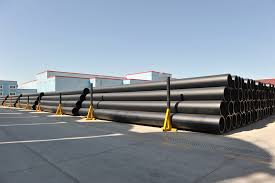Jul . 27, 2024 04:02 Back to list
Exploring the Benefits and Applications of Wholesale PPR Pipe Usage in Construction Projects
The Wholesale Use of PPR Pipe A Sustainable Solution for Plumbing Systems
In recent years, the plumbing industry has witnessed a significant shift towards the wholesale use of Polypropylene Random Copolymer (PPR) pipes. These pipes, known for their durability and versatility, are becoming increasingly popular among contractors, builders, and plumbing professionals. This article explores the reasons behind the growing acceptance of PPR pipes, their benefits, and their impact on sustainable construction practices.
What is PPR Pipe?
PPR pipe is a type of plastic piping made from polypropylene, a thermoplastic polymer. Unlike traditional materials such as PVC or metal, PPR pipes offer a range of advantages that make them an attractive option for various plumbing applications. With excellent resistance to corrosion and chemical degradation, these pipes can be used for hot and cold water supply systems, heating installations, and even in industrial applications.
Benefits of Wholesale PPR Pipe Usage
1. Durability and Longevity One of the key advantages of PPR pipes is their exceptional durability. They can withstand high temperatures and pressure, making them suitable for a wide range of environments. PPR pipes also boast a long lifespan, ranging from 50 to 100 years, which ultimately results in lower replacement and maintenance costs.
2. Environmental Impact As the global community becomes increasingly aware of environmental issues, the plumbing industry is looking for solutions that contribute to sustainability. PPR pipes are manufactured from recyclable materials, and their production involves less energy compared to traditional metal pipes. Moreover, their longevity means that fewer resources are consumed over time, making them an eco-friendly choice.
wholesale use of ppr pipe

3. Ease of Installation PPR pipes are lightweight and easy to handle, which simplifies the installation process. This can lead to significant time and labor cost savings for contractors. Furthermore, the fusion welding technology used in joints eliminates the need for adhesives or additional fittings, ensuring leak-proof connections.
4. Resistance to Scaling and Biofilm Growth Unlike conventional metal pipes that may suffer from scaling or corrosion, PPR pipes have a smooth inner surface that minimizes the buildup of scale and inhibits biofilm growth. This characteristic ensures clean, safe water delivery and reduces maintenance requirements.
5. Cost-Effectiveness While the initial cost of PPR pipes may be higher than some alternatives, their long-term benefits often outweigh this expense. With reduced maintenance and replacement costs, lower energy consumption, and longer service life, PPR pipes prove to be a cost-effective solution in the long run.
The Future of PPR Pipes in Wholesale Markets
The wholesale market for PPR pipes is positioned to grow as more builders and contractors recognize these pipes' value. Countries around the world are adopting PPR as a preferred material for plumbing systems, driven by both sustainability goals and economic considerations. In regions where access to clean water is critical, the use of PPR pipes can enhance infrastructure reliability and efficiency.
As we move towards a more sustainable future, the wholesale use of PPR pipes represents a step forward in improving plumbing systems while also addressing environmental concerns. By investing in durable, recyclable, and environmentally friendly materials, the plumbing industry can significantly reduce its carbon footprint, contributing to a healthier planet for future generations.
In conclusion, the wholesale adoption of PPR pipes is not just a trend but a necessity in modern plumbing practices. With the myriad of benefits they offer, it is clear that PPR pipes are a smart investment for builders, contractors, and municipal water supply systems. As we continue to prioritize sustainability and efficiency, PPR pipes will play a crucial role in shaping the future of plumbing infrastructure.
-
High-Quality PVC Borehole Pipes Durable & Versatile Pipe Solutions
NewsJul.08,2025
-
High-Quality PVC Perforated Pipes for Efficient Drainage Leading Manufacturers & Factories
NewsJul.08,2025
-
High-Quality PVC Borehole Pipes Durable Pipe Solutions by Leading Manufacturer
NewsJul.08,2025
-
High-Quality PVC Borehole Pipes Reliable PVC Pipe Manufacturer Solutions
NewsJul.07,2025
-
High-Quality UPVC Drain Pipes Durable HDPE & Drain Pipe Solutions
NewsJul.07,2025
-
High-Quality Conduit Pipes & HDPE Conduit Fittings Manufacturer Reliable Factory Supply
NewsJul.06,2025

